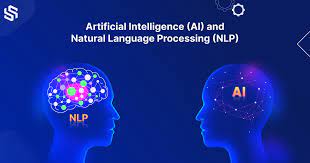How to Implement AI In Natural Language Processing (NLP)

According to Wikipedia Natural language processing is an interdisciplinary subfield of computer science and linguistics. It is primarily concerned with giving computers the ability to support and manipulate speech.
The cutting edge of artificial intelligence is Natural Language Processing (NLP), which is transforming how computers communicate and comprehend human language. NLP has developed into a vital tool for companies and organizations, whether they are using chatbots, sentiment analysis, or language translation. We’ll examine how to successfully integrate AI with NLP in this post.

Understanding NLP and Its Applications
Understanding natural language processing (NLP) and its wide range of applications is crucial before implementing NLP. NLP is the area of artificial intelligence that focuses on the interface between computers and human language.
- Sentiment Analysis: Determining the sentiment (positive, negative, neutral) in user-generated text data, such as social media comments or product reviews.
- Chatbots and Virtual Assistants: Developing conversational AI systems that can understand and respond to natural language input, improving customer service and automating tasks.
- Language Translation: Creating multilingual AI systems capable of translating text and speech in real-time.
- Text Summarization: Automatically generating concise summaries of lengthy documents or articles.
- Named Entity Recognition (NER): Identifying and categorizing entities (e.g., names of people, organizations, or locations) within text data.
- Language Understanding: Analyzing user queries to extract intent and context, enabling better search results and user experiences.
Steps to Implement AI in NLP
1. Define Clear Objectives
Make sure your goals are clear before you begin using NLP. Which particular issue or task do you want NLP to help you with? A clearly defined goal is essential, whether the goal is to improve search capabilities, automate content creation, or improve customer service.
2. Data Collection and Preprocessing
NLP is very dependent on high-caliber data. Compile pertinent textual information from a variety of sources, making sure it is clear, organized, and reflects the issue you are trying to solve. To prepare the data for analysis, data preprocessing procedures include text tokenization, stemming, and stop word removal.
3. Choose the Right NLP Tools and Libraries
Choose NLP tools and libraries that fit the needs of your project. For pre-trained models, popular options include NLTK, spaCy, and the Hugging Face Transformers library. These programs offer crucial features for text analysis and processing.
4. Model Selection and Training
For your work, select the NLP model architecture that is most appropriate. Pre-trained models like as BERT, GPT-3, or T5 might be a good place to start for a lot of NLP applications. To better fit these models to your situation, fine-tune them using the dataset you have in hand.
5. Evaluation and Fine-Tuning
Utilizing pertinent indicators, assess the performance of your NLP model. Based on the application, common measures include recall, accuracy, precision, F1-score, and perplexity. Iteratively refine the model in light of the evaluation’s findings.
6. Deployment and Integration
Add your trained NLP model to your system or application. Make sure it can scale as needed and handle requests in real time. Deployment can be made easier by using cloud-based services like Microsoft Azure NLP, Google Cloud Natural Language, and AWS Comprehend.
7. Monitoring and Maintenance
Maintaining the efficacy of your NLP system over time requires constant monitoring. Establish warnings for anomalous behavior, and periodically retrain the model with new information to maintain its accuracy and currentness.
8. User Experience and Feedback
Maintaining the efficacy of your NLP system over time requires constant monitoring. Establish warnings for anomalous behavior, and periodically retrain the model with new information to maintain its accuracy and currentness.
9. Ethical Considerations
In NLP, pay particular attention to ethical issues like bias reduction and detection. Make sure your NLP system complies with privacy and data protection laws and treats every user equally.
Conclusion
Businesses and organizations looking to improve communication, automation, and decision-making may find that implementing AI in natural language processing is a game-changer. You can utilize NLP to provide creative solutions and enhance user experiences by following these guidelines and keeping up with developments in the field. Recall that NLP is a quickly changing area, therefore maintaining your competitive edge and being able to handle new difficulties successfully requires constant learning and adaptability.








